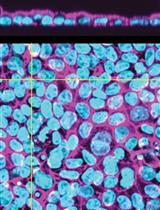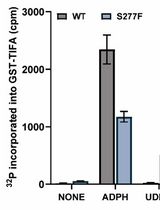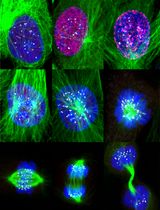- EN - English
- CN - 中文
Phospho-protein Analysis in Adherent Cells Using Flow Cytometry
利用流式细胞术进行贴壁细胞的磷酸化蛋白分析
发布: 2019年10月20日第9卷第20期 DOI: 10.21769/BioProtoc.3395 浏览次数: 5933
评审: Ralph Thomas BoettcherRAVI THAKURMasashi Asai

相关实验方案

自动层次分析(ALAn):用于无偏见表征培养中哺乳动物上皮结构的图像分析工具
Christian Cammarota [...] Tara M. Finegan
2024年04月20日 4158 阅读
Abstract
Protein phosphorylation is one of the most important post-translational modifications, which acts as a reversible on or off switch for the activity of a large number of proteins. Analyzing the phosphorylation status of different proteins can reveal the alterations in the state of the cells in response to cellular damage, cancer and pharmaceutical drugs. Techniques such as mass spectrometry, radiolabeling, 2D-gel electrophoresis and western blotting are used to quantify protein phosphorylation. These assays can quantify phosphorylation in the bulk population of cells, however, flow cytometry can couple cell surface marker expression data with phosphorylation data to understand differential signaling in a sub-population within a heterogeneous population of cells. Our protocol describes the use of flow-cytometry for rapid and single cell-based quantification of intracellular phospho-protein with the help of anti-phospho protein specific antibody.
Keywords: Phospho-protein (磷酸化蛋白)Background
Protein phosphorylation is one of the most intensively studied post translation modifications. Protein phosphorylation acts as an “on” or “off” switch for the target protein activity and thereby modulates a large number of pathways and biological processes (Hunter, 1995). Phosphorylation of proteins is reversibly mediated by the action of two classes of enzymes namely; protein kinases and protein phosphatases, which together constitute the largest enzyme family, spanning 2% of the human genome (Venter, 2001; Manning et al., 2002; Alonso et al., 2004). It is estimated that one in three proteins undergoes phosphorylation during its lifetime. Given the scale of impact and importance of protein phosphorylation in dictating protein function, tight regulation of phosphorylation by protein kinases and phosphatases play vital role in signal transduction, cell differentiation, development, cell cycle control and metabolism (Delom and Chevet, 2006; Ardito et al., 2017). Protein kinases can be divided into two major groups based on the site of phosphorylation; serine/threonine kinases and tyrosine kinases (Roskoski, 2015). Whereas up to 86.4% of all phosphorylation modifications occur at serine residues, followed by 11.8% at threonine residues, less than 2% occur at tyrosine residues (Ardito et al., 2017).
The analysis of phospho-proteins is coupled with a myriad number of complications. Majority of proteins exist as a heterogeneous population, wherein the phosphorylated fraction is generally low in abundance and it exists in several different phosphorylated forms. The reversible nature of phosphorylation due to activity of phosphatases further necessitates crucial precautions during the processing of samples (Delom and Chevet, 2006). Mass spectroscopy analysis enables identification and quantification of post-translation modifications of proteins at a large scale (Steen et al., 2006; Junger and Aebersold, 2014; Pan et al., 2015). Two-dimensional gel electrophoresis can exploit the difference in isoelectric point of phosphorylated variant of a protein to quantify phosphorylated fraction (Guy et al., 1994). Use of phospho-protein specific antibodies conjugated with fluorophores allows single cell based rapid quantification with the help of flow cytometry (Krutzik and Nolan, 2003). Flow cytometry offers reduction in the number of processing steps as compared to western blotting and enables multiplex analysis of different types of cells and phospho-proteins (Krutzik et al., 2004; Davies et al., 2016). Whereas traditional biochemical assays can only quantify phosphorylation in the bulk population of cells but cannot determine the signaling differences in a sub-population within a heterogeneous population of cells, flow cytometry can couple cell surface marker expression data with phosphorylation data to understand differential response of different cell types to a ligand or inhibitor (Krutzik et al., 2004). Phospho-protein flow cytometry can be used to study signaling pathways in stem cells (Sonowal et al., 2013), cancer cells (Kumar et al., 2017) and understand cell-cell interaction (Kumar et al., 2018). We developed a reliable method to analyze phospho-proteins in adherent cells. Adherent cells require an additional step, where the cells have to be enzymatically detached from the cell growth surface and can lead to inactivation of phospho-proteins. This protocol described here can be used to successfully quantify the intracellular phospho-proteins in adherent cell types.
Materials and Reagents
- Bio-hazard waste container (Tarsons, catalog number: 583254)
- Cell culture dish, 100 x 20 mm (Eppendorf, catalog number: 0030702115)
- T25 flasks (Eppendorf, catalog number: 0030710118)
- FACS tubes (Corning, catalog number: 352063)
- Graduated centrifuge tubes, 15 ml (Tarsons, catalog number: 546021)
- Graduated centrifuge tubes, 50 ml (Tarsons, catalog number: 546041)
- Graduated 0.2-10 μl micro-tips (Tarsons, catalog number: 521000)
- Graduated 2-200 μl micro-tips (Tarsons, catalog number: 521010)
- Graduated 200-1000 μl micro-tips (Tarsons, catalog number: 521020)
- Serological glass pipettes, 10 ml (Himedia, catalog number: CG316-1x10NO)
- Sterile filtration unit (0.22 μm) (Thermo Fisher Scientific, catalog number: 450-0020)
- Storage vial, 5 ml (Tarsons, catalog number: 523070)
- MDA-MB-231 breast cancer cell line (NCCS, Pune)
- 10x Trypsin (2.5%) (Thermo Fisher Scientific, catalog number: 15090-046)
- Anti-Smad1 (pS463/pS465)/Smad8 (pS465/pS467) PE conjugated antibody (BD Biosciences, catalog number: 562509)
- Bovine serum albumin (BSA) (Himedia, catalog number: MB083-5G)
- De-ionized water (dH2O) (Merck, Elix Type 2 pure water)
- Di-sodium hydrogen phosphate (Na2HPO4) (Merck, catalog number: 61755005001046)
- DMEM-high glucose with L-Glutamine medium (DMEM-HG) (Sigma-Aldrich, catalog number: D5648-1L)
- Fetal Bovine Serum (FBS) (Thermo Fisher Scientific, catalog number: 10270)
- Formaldehyde solution 37-41% (w/v) (Merck, catalog number: 61780805001730)
- Hydrochloric acid 35% (HCl) (Merck, catalog number: 61762505001730)
- Dimethyl sulfoxide (DMSO) (Sigma-Aldrich, catalog number: D8418-250ML)
- LDN193189 hydrochloride (Sigma-Aldrich, catalog number: SML0559-5MG)
- Methanol (Merck, catalog number: 82228305031730)
- Potassium chloride (KCl) (Merck, catalog number: 61779205001730)
- Potassium dihydrogen phosphate (KH2PO4) (Merck, catalog number: 60487305001730)
- Sodium bicarbonate (NaHCO3) (Sigma-Aldrich, catalog number: S5761)
- Sodium chloride (NaCl) (Merck, catalog number: 1.93206.0521)
- Sodium hydroxide (NaOH) (Merck, catalog number: 61843805001730)
- Trypan blue (Sigma-Aldrich, catalog number: T6146)
- 100x Penicillin (10,000 Units/ml)-Streptomycin (10,000 Units/ml) antibiotic (Thermo Fisher Scientific, catalog number: 15140-122)
- DMEM medium (see Recipes)
- PBS (see Recipes)
- 1x Trypsin (see Recipes)
- Heat inactivated FBS (see Recipes)
- 0.4% trypan blue (see Recipes)
- 4% formaldehyde solution (see Recipes)
- Staining buffer (see Recipes)
- LDN193189 Hydrochloride stock (see Recipes)
Equipment
- Hemocytometer (Sigma-Aldrich, catalog number: Z359629-1EA)
- Analytical balance (Sartorius, Quintix Analytical Balance 60, 120 g x 0.01, 0.1 mg)
- Autoclave*
- Biosafety cabinet class II (Thermo Fisher Scientific, model: 1300 series A2)
- Centrifuge (Thermo Fisher Scientific, Sorvall Legend X1R centrifuge, catalog number: 75004260)
- CO2 incubator (Thermo Fisher Scientific, Hera Cell 150i)
- Flow cytometer (Becton Dickinson, FACS calibur and BD cell quest software)
- Inverted microscope with camera (Zeiss, Axio Vert A1)
- Vortex mixer (IKA, model: MS-3D)
- Micropipettes (Thermo Fisher Scientific, Finnpipette F2–10 μl, 100 μl and 1,000 μl)
- Pipette controller (Socorex, Profiller 446)
- Magnetic Stirrer (Tarsons, catalog number: 6090)
- 4 °C refrigerator*
- -20 °C refrigerator*
*Note: These items can be ordered from any qualified company. - -80 °C refrigerator (Thermo Fisher Scientific, FORMA 88000 Series)
- Water bath (Thermo Fisher Scientific, Labline water bath)
Software
- FlowJo Software (FlowJo, LLC)
Procedure
文章信息
版权信息
© 2019 The Authors; exclusive licensee Bio-protocol LLC.
如何引用
Sharma, R., Sharma, A., Kumar, A. and Jaganathan, B. G. (2019). Phospho-protein Analysis in Adherent Cells Using Flow Cytometry. Bio-protocol 9(20): e3395. DOI: 10.21769/BioProtoc.3395.
分类
细胞生物学 > 细胞信号传导 > 磷酸化
细胞生物学 > 细胞成像 > 固定细胞成像
您对这篇实验方法有问题吗?
在此处发布您的问题,我们将邀请本文作者来回答。同时,我们会将您的问题发布到Bio-protocol Exchange,以便寻求社区成员的帮助。
Share
Bluesky
X
Copy link










